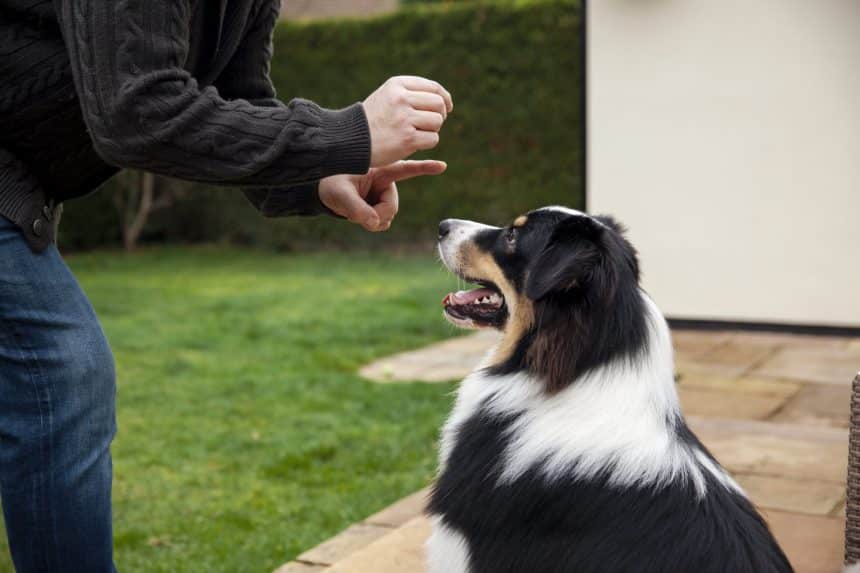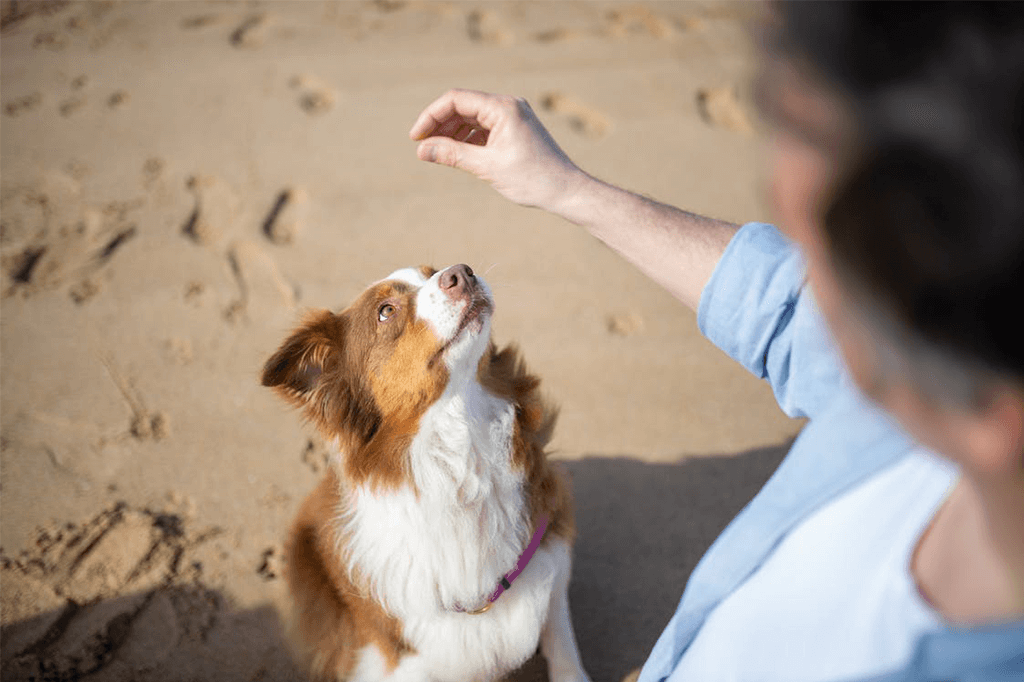Table of Contents
Have you ever heard that communication is the key? Well, this tip comes in handy when we talk about essential dog training. Whether it is hunting dog training, basic commands, or bubble theory dog training, the use of hand signals is a must. Dog training hand signals simplifies communication and is useful for deaf dogs. They can just identify your hand gestures and understand the command you are giving to them. So, this article guide specifically focuses on hand gestures to train your dog efficiently. So, if you own a pet, get ready to simplify the communication between you and your furry friend.
Dog Training: Hand Signals for Reliable Communication
Hi there! Are you prepared to advance your dog training? Let’s learn about hand signals. In addition to training your dog verbally, using visual cues can be quite beneficial. Your pet’s interest changes naturally when you lift your hand, palm facing up. To get them closer, try gesturing with your index finger in a circular manner. Body language is quite effective in communicating with dogs, so make sure your movements are clear and constant. To teach “sit,” for example, just raise your hand and place it palm facing forward. Your dog’s nose will pick up on the movement quickly. Learning hand signals for training dogs is easy and will strengthen your relationship with your dog while making obedience fun for both of you.

Why Hand Signals are Important in Dog Training?
Training your dogs with hand signals is very important for a number of reasons.
1. Enhanced Communication
Since body language frequently talks louder than words, using hand gestures helps you and your dog communicate more clearly.
2. Visual Clarity
Since dogs are skilled readers of body language, using hand signals gives them visible signals to follow that are easy to understand and react to.
3. Multi-Sensory Learning
Teaching your dog with verbal instructions and training hand signals activates several senses, strengthening commands while improving memory.
4. Versatility
Hand signals work in a variety of situations and contexts when voice instructions are not successful, such as in noisy areas or when your dog is far away.
5. Universal Understanding
Training dogs with hand signals breaks down language barriers and improves communication with dogs from diverse backgrounds or in multilingual families, in contrast to spoken orders that could be language-specific.
6. Fine-Tuning Commands
You can give more detailed instructions and corrections as needed by using hand signals, which enable you to make minor changes and fine-tune commands.
7. Bond Strengthening
Teaching your dog hand signals requires mutual trust, understanding, and collaboration, and it strengthens the bond with your companion.
In addition to spoken orders, adding hand signals to your training repertoire can result in quicker and more consistent obedience, which will make training more effective and pleasurable for both you and your pet.

Important Dog Training Hand Signals
There are some important signals when it comes to dog training. Let’s discuss some of the important dog signals in this section of the article.
1. Sit: Basic Dog Training Hand Signals
The most important hand signal when it comes to basic dog training is teaching them sit command. This can be done using verbal cues and verbal commands or with hand signals. The dog training hand signal for sit is as simple as any other.
- Raise your hand and fingers together, with your palm facing outward.
- Smoothly raise your hand upward so that it resembles a stop sign. This motion tells your dog to take a seat. It’s crucial to make sure your hand is elevated so your dog can see properly.
2. Stay: Important Technique in Dog Training Hand Signals
The second most important hand signal is stay. This is an easy-to-learn signal that eliminates the need to shout loudly. You just have to make a hand movement, and your dog will stay where he is.
- Stretch your arm out in front of you, palm facing your dog.
- While keeping your eyes open, slowly lower your hand toward the ground.
- This signal tells your dog to stay where they are until they are released. Your hand’s downward motion serves to bring out the sense of remaining motionless or grounded.
3. Come: Teach them Essential Dog Training Hand Signals
Coming towards the next hand signal, you can teach your dog with your hand to come towards you or any other object.
- Stretch out your arm with your fingers together and your palm facing up.
- Make an inviting gesture with your fingers, curving inward toward your body. Your dog is invited to approach you with this gesture. Your dog is encouraged to approach in a warm and inviting manner with your open palm and beckoning gesture.
4. Down
The next basic dog training handing signal is teaching your furry fellows “down”. This is an easy-to-teach movement when you want your pet to stay at a place.
- Stretch your arm forth with your palm toward the floor.
- Swing your hand downward and in the direction of the earth. Your dog is instructed to lie down by this signal. Because the downward motion resembles lying down, it will be easier for your dog to learn the required habit.
5. Heel: Learn Dog Training Hand Signals
The next dog obedience training hand signals is teaching them the art of “Heel”.
- Keep your hand by your side with the palm pointing inward.
- Feel free to tap your thigh with your fingers or gesture to your side. This signal, which is usually used on leash walks, tells your dog to walk closely beside you. Your dog is encouraged to settle in near to you by the tapping or inviting motion.
6. Stay Here: Patient Dog Training Hand Signals
Coming towards the next hand signal, one of the common dog training hand signals is stay here.
- Stretch your arm out in front of you, palm facing your dog.
- Make a visual barrier by rotating your hand in a circular motion. This signal, which is frequently used during outside activities or off-leash training, instructs your dog to remain in a certain spot. The circular motion helps highlight the importance of remaining in an established region.
7. Wait
Teaching your pet to wait while they are doing something is making them wait and postpone the action.
- Reach forward and extend your arm with your palm toward your dog.
- Make a stopping gesture with your hand by moving it up and down. This signal, which is frequently used before crossing roads or going through doors, tells your dog to stop for a short while. The movement from top to bottom simulates stopping or pausing.
8. Leave It
Leave it is also an important technique for teaching dogs. Let’s see how to teach this amazing technique.
- Lift your arm and turn your palm toward your dog.
- With your hand, move it in a sweeping manner from side to side. This motion tells your dog to put whatever they are concentrating on aside or to stay still. The sense of moving away from the object of focus is emphasized by the sweeping motion.
9. Watch Me: Observing Dog Training Hand Signals
- Move your index finger in a circular motion in the direction of your eyes.
- Point your finger at your face to get your dog to focus on your eyes. This signal, which is frequently used to regain concentration during distractions, encourages your dog to focus their attention on you. When you point with your eyes, your dog will focus on you as the main object of attention.
10. Release: Crucial Dog Training Hand Signals
- Spread your palm outward while opening your hand.
- Use a phrase of release like “free” or “okay.”
- Your dog will understand that they are no longer in the remain or command position when they see this gesture. The gesture of an open hand and outward motion denotes liberty and consent to move or take action.
If you want to learn about how to attract a dog’s attention, check out this blog.

Common Behavior Challenges in Dog Training
Many behavioral issues might arise during dog training; some of these issues are typical for dog owners. These difficulties could be brought on by things like breed tendencies, outside influences, or past encounters. In dog training, the following common behavioral issues arise:
1. Pulling on the Leash
Dogs frequently pull on the leash, which ruins walks and makes them frustrating. This behavior could be the result of curiosity, excitement, or insufficient leash training.
2. Jumping Up
As a greeting or sign of eagerness, dogs may leap up on people. Even though it’s frequently a gesture of affection, there may be issues with it, particularly if the dog is big or the owner finds the action upsetting.
3. Barking
Both dog owners and passersby may find excessive barking to be bothersome and disruptive. Dogs may bark to communicate, to show that they are bored, or to react to anything outside of them.
4. Chewing
Dogs use their teeth to look into their surroundings; thus, chewing is a natural habit. On the other hand, bad chewing habits, such as chewing through shoes or furniture, can be troublesome.
5. Digging
While many dogs find digging to be a natural pastime, it can become bothersome when it damages lawns, gardens, or home objects.
6. Aggression
Acting aggressively toward people, other dogs, or animals might present a significant behavioral problem. It can appear as lunging, biting, or growling and be brought on by lack of socialization, fear, or territoriality.
7. Separation Anxiety
When a dog is left alone, it can cause anxiety, which might manifest as behaviors like excessive barking, destructive chewing, or escape attempts.
8. Resource Guarding
Dogs that get overly attached to food, toys, or other stuff may act aggressively toward anyone who comes near them.
9. Counter Surfing
Dogs may get into the habit of leaping up onto tables or countertops to pilfer food or other goods, which puts their safety in danger and may even cause damage to property.
10. Not Coming When Called
Although recall is a crucial ability for dogs, some may find it difficult to respond when called, especially when they are off-leash or in distracting situations.
It frequently takes persistence, patience, and positive reinforcement training methods to address these behavioral issues. To create a customized training program, consulting with a behaviorist or professional dog trainer may be helpful in some situations.
Conclusion
Wrapping up, this article covered dog training hand signals. All the important and common hand gestures are discussed. Moreover, their behavior can significantly be improved by using hand movements and teaching them valuable movements.

